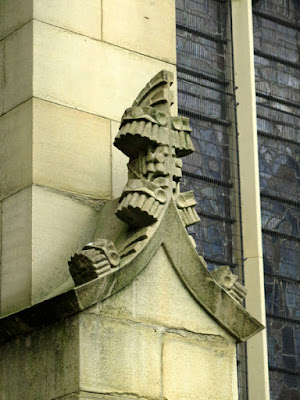 |
| A general view of the east end of Wakefield Cathedral |
After taking a quick look at the exterior of the Chantry Chapel of St. Mary the Virgin, which has has been extensively restored over the years, a 10 minute walk took me to the Cathedral Church of All Saints, where the highest spire in Yorkshire dominates the old town centre of Wakefield.
 |
| The east end of the cathedral |
Founded on a Saxon church and subsequently rebuilt and extended at various times during the mediaeval period, the exterior is essentially the product of another extensive restoration by Sir George Gilbert Scott between 1858-1874 and the addition of the east end in 1904 by F L Pearson, based on designs by his father - John Loughborough Pearson.
When approaching from the east, there is a clear difference in the colour of the ashlar masonry between these two periods and, from a distance, both appear to be built out of stone that is generally uniform and without obvious variations in colour or texture. It is only when looking closely at the aisles that it is clear that the stones used to build the walls and dressings are very different.
 |
| Different sandstones used for walling and dressings |
The 1941 edition of the British Geological Survey memoir for Wakefield mentions that Wakefield Cathedral was restored using stone from the Woolley Edge Rock, but it is only the walling – with its distinctive cross-bedding and pink/brown colouration – that bears any resemblance to the stonework seen in the chapel of St. Mary the Virgin on the bridge.
 |
| The north aisle |
Although the means of transport available to mediaeval builders restricted their choice of building materials, by the time that Sir George Gilbert Scott undertook his restoration of very many churches, an extensive network of canals and railways had already been established and the building stone used here could have been brought in from anywhere in Yorkshire - where the best quality sandstones were being extensively quarried.
 |
| A detail of a recurring architectural motif |

No comments:
Post a Comment